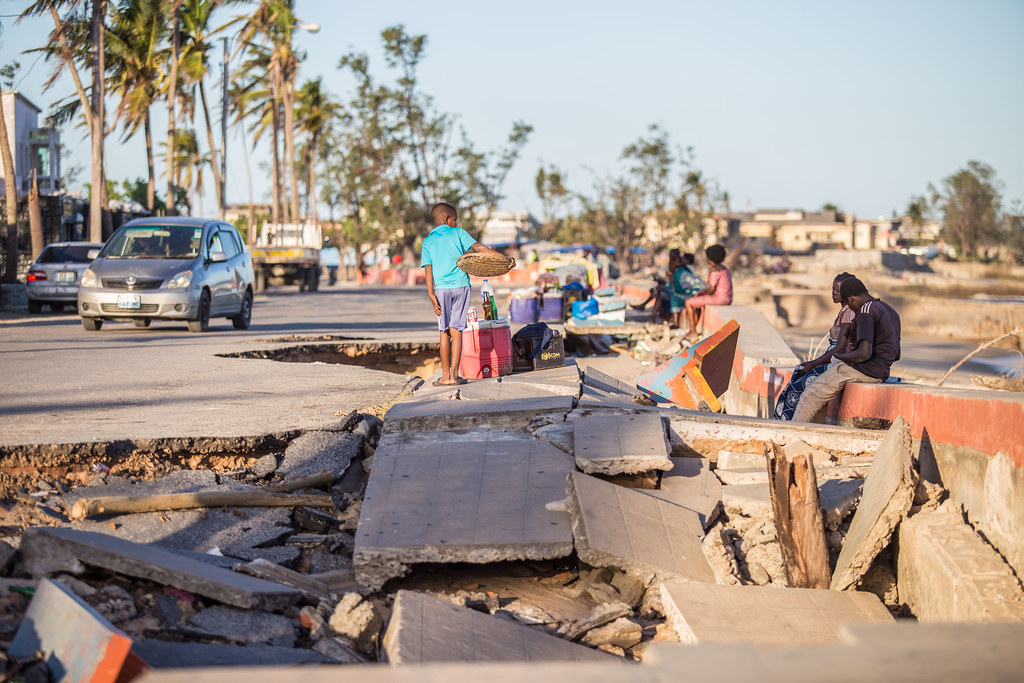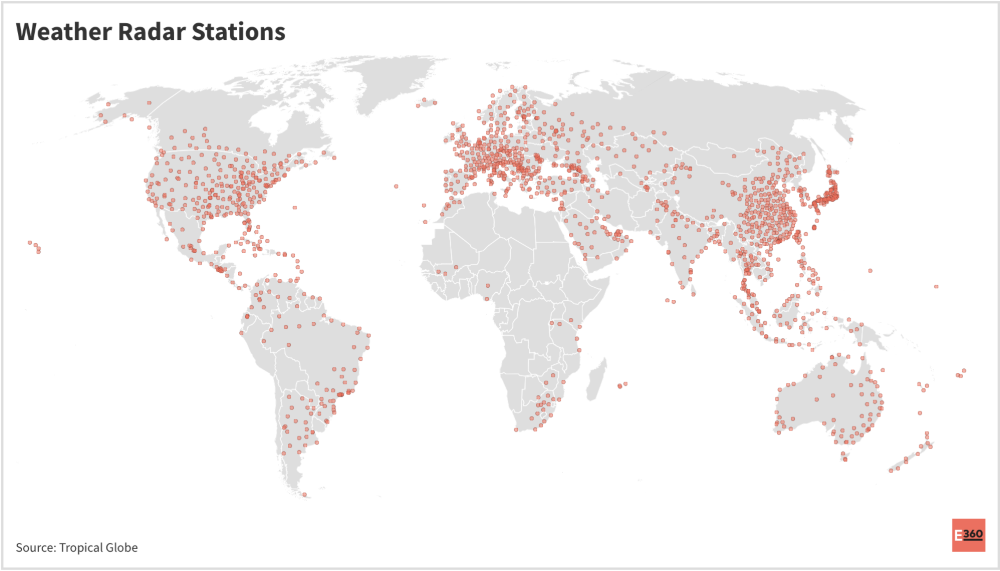Without Warning: Africa’s Lack Of Weather Stations Is Costing Lives

In 2019, Cyclone Idai killed more than 1,000, particularly affecting Beira in Mozambique. Credit: World Bank / Sarah Farhat.
The US and EU, with a population of 1.1 billion, have 636 weather radar stations. Africa, with a population of 1.2 billion, has just 37.
In early-May, heavy rainfall led to severe flooding and hundreds of landslides around Lake Kivu, on the border between Rwanda and the Democratic Republic of the Congo (), killing at least 600 people. The floods, which caught many as they slept, also displaced thousands of people, destroyed water infrastructure, and damaged productive farm fields.
Floods are one of the deadliest natural disasters worldwide, but deaths linked with flooding aren’t distributed evenly. They most often occur in places that lack weather data and warning systems — and most of those places are in the Global South. While the rainfall around Lake Kivu this past spring was extremely heavy, it was the lack of warming that turned this weather event into a humanitarian disaster.
To avoid similar disasters in the future, countries in Africa and other parts of the world need funding for early warning systems, weather stations, and climate modelling. Such investments will benefit people the world over.
In 2015, I co-founded World Weather Attribution, an international science initiative that studies extreme weather events to assess whether, and to what degree, human-caused climate change affected the intensity and likelihood of a particular weather event. Most of our studies on flooding, as expected, have found that rain events have been made more intense by climate change.
But studying the deadly flooding in Rwanda and the DRC this past June, my organisation came up short. That’s because large parts of Africa lack functional weather stations — or a sufficiently dense network of stations — to record daily measurements like rainfall, temperature, humidity, barometric pressure, and wind intensity and direction. We couldn’t find enough data on how much rain had fallen, when, and where around Lake Kivu.
According to the World Meteorological Organisation (WMO), the US and European Union combined have 636 weather radar stations for a population of 1.1 billion, while Africa, with a population of 1.2 billion, has just 37, which are unevenly distributed across the continent. The WMO also notes that some 60% of the African population is “not covered by early warning systems to cope with extreme weather and climate change”. What weather stations the continent does have are often so far apart that the data they collect is of limited use, and many of those stations are in need of repair. In fact, only one in five African weather stations met the WMO’s reporting standards in 2019, and the number of functional weather stations in Africa has been decreasing in recent decades due to a lack of maintenance.
Early warnings of an impending disaster give people a chance to seek shelter or evacuate. Compare 2021’s Hurricane Ida in the US with 2019’s Tropical Cyclone Idai in East Africa. Both were Category 4 storms, but Ida killed fewer than 100 people, while Idai killed more than 1,000. Early warning was a key difference between the two disasters. “US residents were alerted to evacuate before Hurricane Ida made landfall, [while] Cyclone Idai caught African populations by surprise,” scientists wrote in .

Distribution of weather radar stations across the world.
In Libya this past September, a lack of early warning and evacuation planning, in combination with ill-maintained infrastructure, led to the deaths of more than 4,300 people when heavy rainfall contributed to massive flooding and the bursting of two dams. (Our World Weather Attribution study found that the rainfall that led to the dam collapses was made at least 50 times more likely by human-caused climate change.) Of course, people must also have the capacity to respond to disasters, but without early warning they cannot even start to prepare anticipatory action.
Trying to understand what happened in Rwanda and the DRC last spring, researchers from Rwanda’s Meteorological Agency collaborating on looked at what data they had from weather stations on the east side of Lake Kivu. They identified heavy rains that fell between 8 pm on 2 May and 9 am on 3 May over five Rwandan districts as the immediate cause for the dramatic flooding east of the lake.
But flooding on the west side of the lake, in the DRC, had been reported in late-April, when no major rainfall had been recorded at the Rwandan stations. Nor could flooding that occurred in the DRC on 4 May and 5 May be linked to rainfall measurements in Rwanda. We believe heavy rain fell in this part of the DRC, but because the DRC’s few weather stations are nowhere near Lake Kivu, we cannot say with certainty exactly what happened. (Satellite data from the region doesn’t offer much help: None of the events identifiable in that data is comparable in magnitude or in temporal or geographic extent to what was observed in Rwanda.) We know that the rainfall around Lake Kivu was extreme in terms of its deadly and destructive impacts, but the events that led to this outcome remain a puzzle.
The implications of such scarce meteorological data are severe. If we don’t know what causes floods in the first place, for example, we can’t build infrastructure to better withstand flooding. If the weather isn’t reliably recorded or not available for research (either because it’s not digitised or it’s been sold by cash-poor governments to private customers, rather than being freely available to researchers), weather models cannot be calibrated. And without accurate models, meteorologists cannot make accurate forecasts and warn people about upcoming extremes, nor can we build better-quality climate models. Such models depend on good representation from the tropics, but we currently lack such data from much of Africa. And so all climate predictions suffer.
Without reliable data, researchers cannot understand how weather is changing on our rapidly warming planet. And without knowing what “normal” weather looks like, they don’t know what is “extreme.” A lack of high-quality data also hinders attribution studies, which affect how policymakers, organisations, and individuals understand and respond to weather- and climate-related risks. The absence of attribution studies could also make it more difficult for African nations to claim climate damages and receive financial assistance from the newly established — but not yet operational — UN loss and damage fund, which aims to compensate developing countries for damages linked to climate change.
Weather observations alone will not save lives, but without them we can neither understand the past nor plan for the future. And there is no time to lose, for every day of weather not recorded means that more crucial data is missing. Africa needs long-term investment to develop climate science programmes, increase local meteorological expertise, maintain weather stations, digitise weather records, and more freely share its data. This work will help guide adaptation planning and advance both climate science and attribution studies, which provide evidence for the climate impacts already affecting the continent.
Investing in early warning systems in Africa will save lives. According to the Global Commission on Adaptation, giving just 24 hours’ notice of an impending hazardous event can reduce damage by 30%. Investing just $800 million in such systems in developing countries, says the WMO, would prevent losses of annually.
While we may never know the exact meteorological history of the Lake Kivu disaster, or how climate change contributed to it, we know for certain that there will be more extreme rain events in the future. Investing in Africa should be a matter of historical justice: the developed Global North must take responsibility for the impacts of colonisation and climate change. But it is also a matter of pure self-interest. The climate is a global system, and continuing to ignore important parts of it will lead to worse climate and weather predictions everywhere.


Comments
Post a Comment